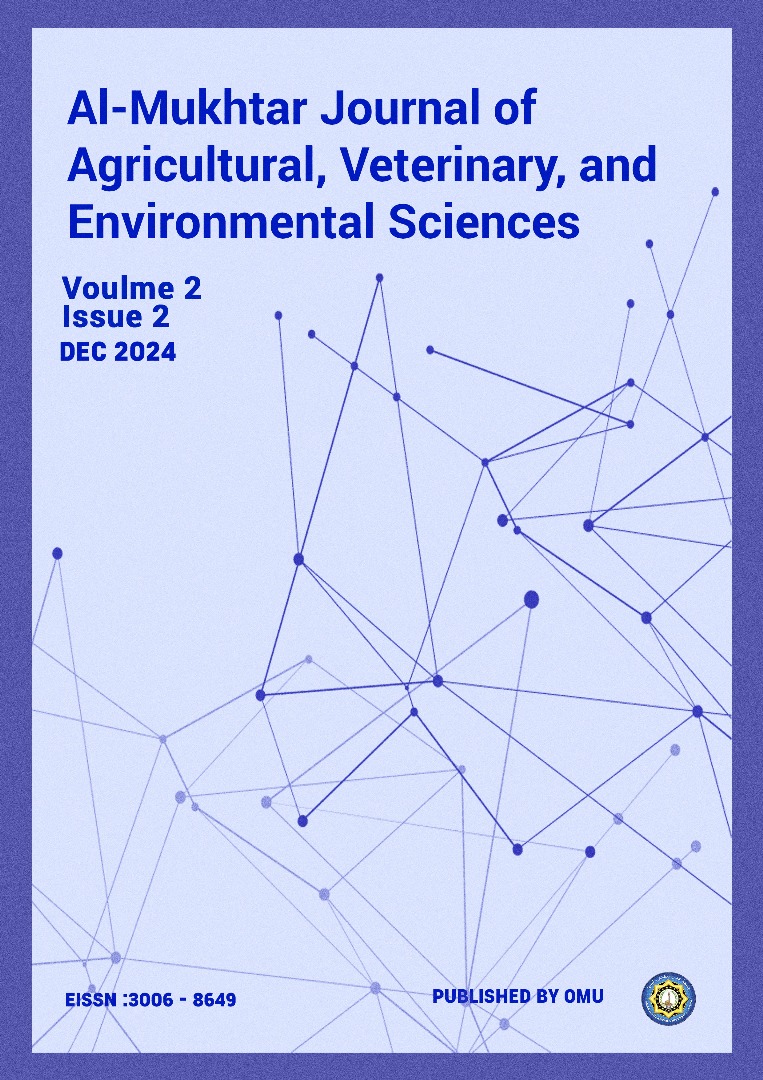Prevalence of Babesia Infection in the Northeastern Part of Libya(Camelus Dromedaries)
DOI:
https://doi.org/10.54172/sya2wa19Keywords:
Babesia Haemoparasitic, protozoa, Piroplasma, camels, North-eastern , LibyaAbstract
A study was conducted to investigate Babesia spp. infections in one-humped camels (Camelus dromedarius) in northeastern Libya. Blood samples were randomly collected from camels of both sexes (115 females and 45 males) across seven selected regions: Tobruk Khoury, Alhamamuh, Sultana, Alqabah, Ajdabiya Road, Qanduluh, and Imsaeid. The sampling period spanned from February 2021 to January 2022. Giemsa-stained blood smears were used to diagnose Babesia spp. infections. The results revealed an overall infection prevalence of 35% among the tested samples. The highest prevalence rates were recorded in Tobruk Khoury (70%), followed by Ajdabiya Road (60.6%), Alhamamuh (60%), Sultana (46.6%), Alqabah (28.57%), Qanduluh (19.35%), and Imsaeid (7.1%).The prevalence among females (42.6%) was significantly higher than that among males (15.5%). Regarding age groups, middle-aged camels (1–15 years) exhibited the highest prevalence rate (45.1%). Seasonally, the highest infection rate was observed in autumn (50%), followed by spring (47.36%).
References
Abd-Elmaleck, B. S., Abed, G. H., & Mandourt, A. (2014). Some protozoan parasites infecting blood of camels (Camelus dromedarius) at Assiut locality, Upper Egypt. J. Bacteriol. Parasitol, 5(2), 1-6.
Abdelrahim, I., Ismail, A., Majid, A., Mohammad, A., Ibrahim, A., Allsop, M., & Oosthuizen, M. (2009). Detection of Babesia caballi in the one-humped Camel (Camelius dromedarius) using the Reverse Line Block (RLB) in Sudan. The Sudan Journal of Veterinary Research, 24, 69-72.
Al-Amery, A., Faraj, A., & Majeed, S. (2017). Detection of Haemoprotozoa in camels in Al-Najaf province, Iraq. Int. J. Adv. Biol. Res, 7(2), 238-241.
Al-mialy, A. J., Hatem, A. A., & AL-Abedi, A. H. J. (2018). Some epidemiological aspects of Piroplasmosis of sheep and camels in desert of Al-Najaf. Kufa Journal For Veterinary Medical Sciences, 9(2), 1-7.
Alimam, H. M., Moosa, D. A., Ajaj, E. A., Dahl, M. O., Al-Robaiee, I. A., Allah, S. F. H., . . . Hadi, E. D. (2022). Proportion and seasonality of blood parasites in animals in Mosul using the Veterinary Teaching Hospital Lab data. Plos one, 17(2), e0264121.
Coles, E. H. (1974). Veterinary clinical pathology: WB Saunders.
El-Naga, T. R. A., & Barghash, S. (2016). Blood parasites in camels (Camelus dromedarius) in Northern West Coast of Egypt. J. Bacteriol. Parasitol, 7(1), 258.
Farhan, B., & Hameed, M. (2017). PREVALENCE OF BABESIA, THEILERIA AND EVALUATED OF SOME BLOOD PARAMETERS IN CAMELS IN AL NAJAF PROVINCE. International Journal of Science and Nature, 8(3), 561-564.
Ibrahim, A. M., Kadle, A. A., & Nyingilili, H. S. (2017). Microscopic and molecular detection of camel piroplasmosis in Gadarif State, Sudan. Veterinary Medicine International, 2017.
Jesca, N., Mary, L. N., Daniel, A., & Duke, O. (2017). Serological prevalence of Babesia caballi and Theileria equi in camels and donkeys from Karamoja sub-region, North-eastern Uganda. Journal of Veterinary Medicine and Animal Health, 9(6), 137-142.
Kamani, J., Turaki, A., Egwu, G., Mani, A., Kida, S., Abdullahi, J., . . . Dogo, G. (2008). Prevalence of gastrointestinal parasites in camels (Camelus dromedarius) slaughtered in Maiduguri, Nigeria. Journal of Camel Practice and Research, 15(2), 181-182.
Mirahmadi, H., Ghaderi, A., Barani, S., Alijani, E., Mehravaran, A., & Shafiei, R. (2022). Prevalence of camel babesiosis in southeast of Iran. Veterinary Medicine and Science, 8(1), 343-348.
Selmi, R., Dhibi, M., Ben Said, M., Ben Yahia, H., Abdelaali, H., Ameur, H., . . . Mhadhbi, M. (2019). Evidence of natural infections with Trypanosoma, Anaplasma and Babesia spp. in military livestock from Tunisia. Trop. Biomed, 36(3), 742-757.
Soulsby, E. J. L. (1968). Helminths, arthropods and protozoa of domesticated animals. Helminths, arthropods and protozoa of domesticated animals.
Swelum, A. A., Ismael, A. B., Khalaf, A. F., & Abouheif, M. A. (2014). Clinical and laboratory findings associated with naturally occurring babesiosis in dromedary camels. Journal of Veterinary Research, 58(2), 229-233.
Wakil, Y., Lawal, J., Gazali, Y., Mustapha, F., Bello, A., Mshelia, E., & Ayomikun, A. (2016). Survey on prevalence of haemoparasites of trade camels (Camelus dromedarius) in Maiduguri; Nigeria. Journal of Veterinary Medicine and Animal Science, 2, 7-10.
Downloads
Published
License
Copyright (c) 2024 Salwa. M.S. fzany (Author)

This work is licensed under a Creative Commons Attribution-NonCommercial 4.0 International License.













